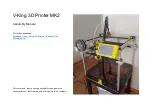
Introduction
PostScript is a programming language that provides extensive
graphics capabilities. PostScript describes appearance of text,
geometric shapes, and sampled images of a page to the printer and
thus is called a page description language. It can rotate, scale, clip,
and orient all graphic objects on all or part of a page.
PostScript is designed to work with raster-output devices. These
devices include laser, dot-matrix, and ink-jet printers, as well as
raster-scan displays. A raster device prints or displays images
consisting of individual dots or pixels (picture elements). On most
black-and-white output devices, each pixel can be made either
black or white; on some devices, each pixel can be set to an
intermediate shade of gray or some color. A page to be printed can
be described simply as an array of pixel values. It describes the
appearance of the entire page, both text and graphics, in abstract
graphical terms rather than in terms of pixels.
How Your Printer Works
The printer is composed of two major parts: the engine and the
controller.
The engine is the main body of the printer where the pages are
physically printed. The controller is the part of the printer which
houses the PostScript software where data is processed for printing.
Information sent to the printer is scanned by the PostScript software
and then processed into a bit-mapped image which is formatted and
stored in page memory. Printing consists of reading the image
information from page memory, serializing it, and outputting the
information on a printed page.
Chapter 9
P o s t S c r i p t : T e c h n i c a l O v e r v i e w
9 - 1
Summary of Contents for PS 410
Page 1: ...QMS PS 410 User s Guide 1800148 001E...
Page 8: ...v i...
Page 14: ......
Page 16: ......
Page 24: ......
Page 26: ......
Page 46: ......
Page 62: ......
Page 82: ......
Page 84: ......
Page 102: ......
Page 114: ......
Page 116: ......
Page 138: ......
Page 140: ......
Page 154: ......
Page 156: ......
Page 170: ......
Page 204: ......
Page 206: ......
Page 222: ......
Page 224: ......
Page 232: ......
Page 240: ......
Page 241: ...Appendix C Optional Accessories Available QMS Accessories C 1...
Page 242: ......
Page 245: ...Appendix D Character Encoding Tables Character Encoding Tables D 1...
Page 246: ......
Page 249: ...Appendix D Symbol Encoding Character Encoding Tables D 3...
Page 252: ......
Page 256: ......
Page 258: ......
Page 280: ......
















































